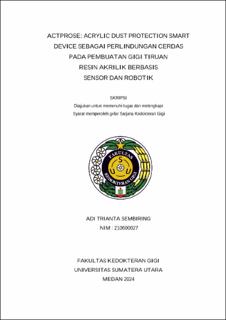| dc.description.abstract | The polishing and finishing process of acrylic resin dentures produces particles that can potentially be inhaled by dental practitioners and patients, causing the pulmonary disease pneumoconiosis. This high risk is exacerbated by the low awareness of the use of medical masks and the ineffectiveness of existing technology in preventing. The purpose of this activity is to produce a protective device that can prevent the scattering of denture acrylic resin particles and can collect them automatically. The making of this device is carried out through several stages, including data collection, design, system modeling, device making and assembly, device testing and inspection, and target user testing. The two main components of the device are work chamber and adjustable leg. Electronic components such as PMS5003 sensors, vacuum and robotic systems, and Arduino Uno are integrated with C language programming. The sensor readings will be displayed on a 20x4 LCD screen so when the sensor detects dust concentrations exceeding 50 micrograms per cubic meter, the vacuum will work automatically and the robotic system cleans the remaining dust by press the push button.
The device has been tested by Balai Pengamanan Alat dan Fasilitas Kesehatan with electrical and performance test parameters. The results obtained are that the acrylic resin debris particle suction device from a sensor and robotic technology based denture plate called Actprose (Acrylic Dust Protection Smart Device) is effective in sucking acrylic resin particles without leakage with 480 Watt power specifications, 226-228 Voltage power supply, PMS5003 dust sensor, arduino uno microcontroller, machifit nema 17 stepper motor, 400 millimeter screw slider, maximum vacuum suction power of 95.5 Torr, and device overall height reaches 85.4-115.4 centimeters. To improve protection, the development of an earthed electrical system is required. It can be concluded that the Actprose device equipped with a PMS5003 sensor, vacuum system and robotics is able to prevent the scattering of acrylic resin particles in the air in order to optimize health protection to dental practitioners and patients when finishing and polishing dentures. | en_US |


